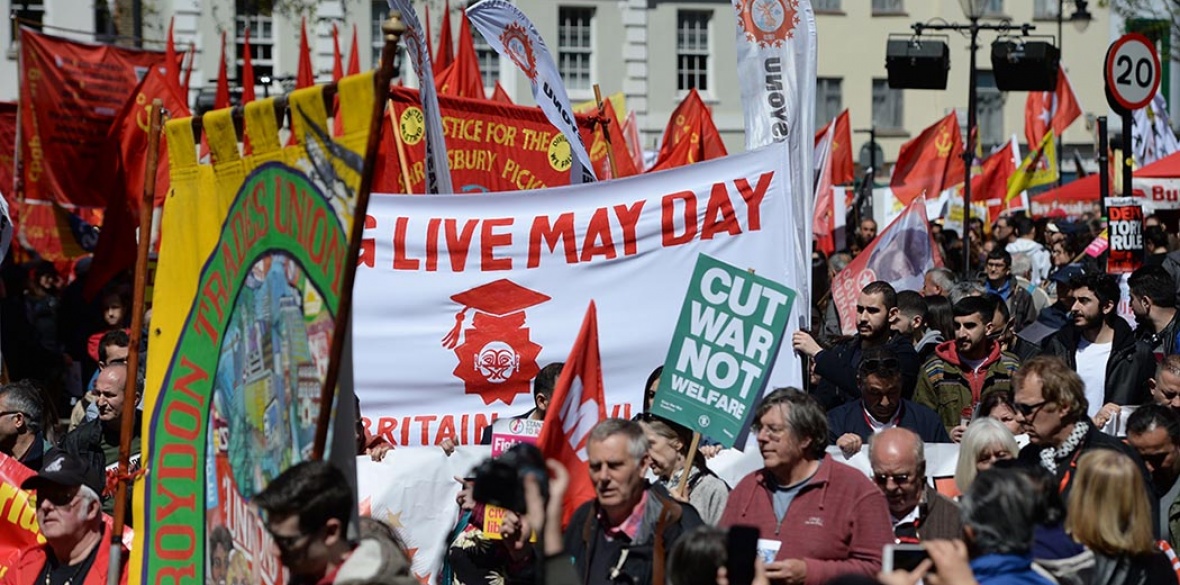This is the last article you can read this month
You can read more article this month
You can read more articles this month
Sorry your limit is up for this month
Reset on:
Please help support the Morning Star by subscribing here
WORKERS all over the world will come together to demonstrate and celebrate May Day — the international workers’ holiday.
May Day has always been a red festival and long before that it has been a widely known green countryside celebration marking the rebirth and regrowth of nature — the rekindling of life after winter.
In this article I’ll try to explore these two parallel histories of this important day. I’ll start with the workers’ celebration when red banners fly in the spring sunshine all across the globe and go on to another, more traditional, celebration of the end of winter and the approach of the better weather of summer.
These two themes are related, of course. It is no coincidence that they both look forward to the celebrations of better times to come.
There are a whole number of reasons that May the first, today, has become the special day for workers all across the globe.
One key anniversary was the commemoration of the 1886 Haymarket affair in Chicago. Police gunfire killed at least four labour march demonstrators and injured many more marchers.
On Tuesday May 4 1886, at Haymarket Square in Chicago, workers organised a peaceful rally in support of those striking for an eight-hour day.
Deliberately and provocatively, someone threw a dynamite bomb at the police as they tried to disperse the meeting.
The bomb blast and ensuing gunfire resulted in the deaths of seven police officers. At least four civilians were killed and scores of others were wounded.
Three years later in 1889, at the first congress of the Second International, which was meeting in Paris, delegates called for international demonstrations on the 1890 anniversary of the Chicago Haymarket killings.
The very next year, May Day was formally recognised as an annual event at the Socialist International’s second congress in 1891.
In 1904, the International Socialist Conference meeting in Amsterdam called on for demonstrations on May 1 for the legal establishment of the eight-hour day.
In many countries, including here in Britain, working-class organisations fought to make May Day an official holiday, and their efforts had many successes all across the globe.
May Day has traditionally been an important official holiday in countries such as the People’s Republic of China, North Korea and Cuba. For many years, in the former Soviet Union and other socialist countries, the day was celebrated by huge televised demonstrations including impressive military parades.
These communist May Day celebrations typically featured elaborate popular pageants and parades with major communist leaders using the day to make keynote speeches.
The biggest of these celebrations was traditionally organised on Red Square, where the general secretary of the Communist Party of the Soviet Union and other party and government leaders stood atop Lenin’s mausoleum, acknowledging the crowds.
Just who was or wasn’t on parade on May Day was often an indication of changes in the party hierarchy.
Kremlin-watchers studied the TV pictures searching for clues of real or imagined inner party rivalries.
So-called cold war military experts did the same thing with the military hardware on parade, looking for scraps of evidence of new weapon systems.
Meanwhile far-right governments have traditionally sought to repress the message behind International Workers’ Day, with fascist governments in Portugal, Italy, Germany and Spain abolishing the workers’ holiday at various times over the years.
The US and Canada might not officially recognise May Day — too much like a celebration of socialism for most of them. They have even tried to hijack Workers’ Day.
The US government attempted to erase history by declaring that May 1 was Law Day instead — a national day to “celebrate the rule of law.” It pronounced that Labour Day was to be on the first Monday of September.
However red flags will still fly and workers still march in every major US and Canadian city today.
Today in Cuba thousands will march in the streets, showing their continuing support for the popular revolution.
In Greece, May 1 is a public holiday, today marked by demonstrations in which left-wing political parties and unions participate.
The notorious right-wing junta, or regime of the colonels, who ruled Greece from 1967 to 1974, banned May Day but today the socialist celebration proves it outlived the reactionary colonels.
The first May Day celebration in Italy took place in 1890. It started initially as an attempt to celebrate workers’ achievements. It was abolished under the fascist regime of Benito Mussolini.
Mussolini was Europe’s first 20th-century fascist dictator. He financed and inspired British fascist Oswald Mosley.
Today May Day is an important celebration in Italy. Today more than half a million people will attend socialist and communist organised rallies, events and concerts.
May Day was celebrated illegally in Russia until the February Revolution enabled the first legal celebration in 1917.
It was a huge celebration in the Soviet years and since 1992, May Day is officially called “the day of spring and labour,” and remains a major holiday in present-day Russia.
In South Africa, Workers’ Day, long banned by apartheid racist forces, has been celebrated as a national public holiday on May 1 each year since 1994, and it became an important celebration in Nelson Mandela’s Rainbow Nation.
In South Africa, Workers' Day celebrates the role played by trade unions, the Communist Party and other labour movements in the struggle against apartheid.
International Workers’ Day, also known as Labour Day and May Day, is observed across China with a three-day holiday. There are speeches by party officials, award ceremonies for model workers and a large-scale evening gala. Anti-Covid restrictions will limit today’s celebrations.
May Day, of course, is a very old celebration, much older than its history as a workers’ holiday. The Celtic pagan festival of Beltane and the Germanic festival of Walpurgis Night are both part of its rich parentage.
Everything in nature, at least in the northern hemisphere, is budding and bursting forth. Birds, bees and all other living things are mating, breeding and creating new life.
Perhaps this has been the inspiration for human actions. Traditionally this day has been an occasion for popular and often raucous and rude celebrations.
Early accounts tell us of young people taking to the woods on the eve of the First of May with predictable fecund results.
As you would expect, the Christian church tried to hijack and clean up the whole shooting match. They were not very successful.
Marxist historian Eric Hobsbawm declared May Day “the only unquestionable dent made by the secular movement in the Christian or any other official calendar.”
Many Christmas carols started life as pagan Maying songs. “God rest you merry gentlemen” was originally sung as “Here’s to you merry Mayer’s all.” The Church of England Hymnal is stuffed with numbers that were once “Top of the Pagan Pops.”
As late at 1955, somewhat worried by the success of Italian communists, Pope Pius XII claimed May Day as the Feast of St Joseph the Worker, to foster deep devotion to St Joseph among Catholics, and in response to the “May Day” celebrations for workers sponsored by communists.
Joseph was the husband of Mary and the father who taught Jesus to be a carpenter. It seems he is the patron saint of we workers.
As so often the Christian tactic was if you can’t beat ’em just nick their best bits and happiest celebrations. The church got away with it with Christmas and Easter, but had a lot less success with May Day.
In Britain it wasn’t until 1978 that the Labour government created May Day as an official bank holiday. The Tories have always hated it and today Boris Johnson and his divided crew can at least all agree they would like to see the back of May Day — despite the fact they do all like a good party.
Many traditional celebrations of May Day as the start of the rebirth of nature in the spring still continue. At dawn this morning Oxford May Morning revellers gathered below the Great Tower of Magdalen College to listen to the college choir sing traditional madrigals.
One or two risked life and limb jumping off Magdalen Bridge into the all too shallow River Cherwell.
Whitstable, Kent, hosts a good example of more traditional May Day festivities, where a character called Jack in the Green leads an annual procession of morris dancers through the town on the holiday.
Padstow in Cornwall holds its annual “Oss” festival, Obby-Oss (Hobby Horse) day of festivities. This is believed to be one of the oldest fertility rites in Britain — revellers dance with the Oss through the streets of the town.
The aim of some of them is to get pregnant in the coming year. Birth rate statistics confirm how well these old festivals still work.
Prior to the slaughter of the first world war, most English villages had a beautiful decorated Maypole. Sadly after the war most were taken down to be replaced by much more solemn war memorials. Thankfully today there are new Maypoles on many a village green.
Scotland celebrates May Day too. In St Andrews, some brave lassies and lads gather on the beach late on April 30 and run naked into the icy North Sea to celebrate May Day sunrise.
Both Edinburgh and Glasgow hold big May Day festivals as well as impressive labour movement parades and rallies.
In Edinburgh, the Beltane Fire Festival is held on the evening of May eve and into the early hours of May Day on the city’s Calton Hill.
An older Edinburgh tradition — a bit sexist perhaps — has it that young women who climb Arthur’s Seat and wash their faces in the morning dew will have lifelong beauty.
Officially the Irish May Day holiday is the first Monday in May.
On May 1 1561, King Charles IX of France received a lily of the valley as a lucky charm. He decided to offer this fragant flower each year to the ladies of the court.
Since the beginning of the 20th century a sprig of lily of the valley became a symbol of springtime and May Day. When I have been in France for May Day I have found French Communist Party stalls selling these fragrant left-wing favours.
You can smell the lovely perfume on political demonstrations and marches. It could only happen in France.
The French Communist Party received special permission to pick and sell this wild flower to mark and honour the leading role it played in the heroic resistance movement against the occupying Nazi forces in the last war.
In rural regions of Germany, especially the Harz mountains, Walpurgisnacht celebrations of pagan origin are traditionally held on the night before May Day, including bonfires and the decorating of a Maibaum or Maypole.
Many German communist, socialist and other leftist political parties and trades unions organise marches or demonstrations.
Wherever you are celebrating this workers’ holiday, in Britain, on one of our many national or regional celebrations or perhaps in more exotic places around the world, remember those red banners will be flying in every corner of the globe today.
The workers’ anthem the Internationale will be sung, its rousing chorus echoing all over the world in a hundred different tongues.
Make sure you join the celebration wherever you can, for today is the International Workers’ Day.
Happy May Day!










